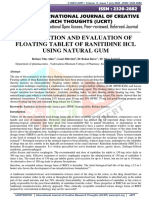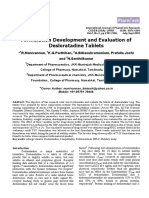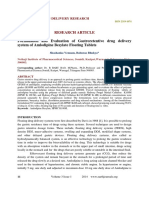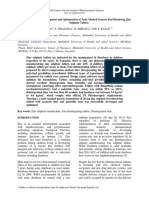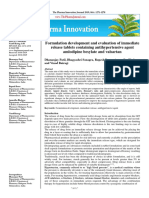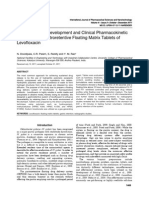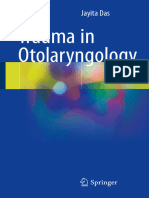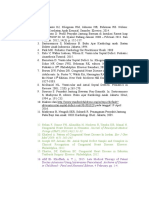Formulation Development and Evaluation of Famotidine Floating Tablet
Formulation Development and Evaluation of Famotidine Floating Tablet
Uploaded by
Cang HaedarCopyright:
Available Formats
Formulation Development and Evaluation of Famotidine Floating Tablet
Formulation Development and Evaluation of Famotidine Floating Tablet
Uploaded by
Cang HaedarOriginal Description:
Original Title
Copyright
Available Formats
Share this document
Did you find this document useful?
Is this content inappropriate?
Copyright:
Available Formats
Formulation Development and Evaluation of Famotidine Floating Tablet
Formulation Development and Evaluation of Famotidine Floating Tablet
Uploaded by
Cang HaedarCopyright:
Available Formats
Volume 4, Issue 3, September October 2010; Article 034
ISSN 0976 044X
FORMULATION DEVELOPMENT AND EVALUATION OF FAMOTIDINE FLOATING TABLET
1
Patel Amit* , Jha Sajal Kumar , Panchal Harishanker , Shukla Tarkeshwar , Shah Arpit
Dept. of Pharmaceutics, NIMS Institute of Pharmacy, NIMS University, Jaipur-, Rajasthan, India.
2
ICPA Health Products Ltd, Ankleshwar 393002, Gujarat, India.
3
Dept. of Pharmaceutics, Sumandeep Vidyapeeth, Vadodara - 391760, Gujarat, India.
*Email: amit_pharmacist1985@yahoo.com
ABSTRACT
The purpose of this investigation was to prepare a floating drug delivery system of famotidine. Famotidine having poor absorption in
acidic environment (upper GIT). When given orally, it shows the bioavailability near to 50%. To overcome these drawbacks, the present
study was undertaken to investigate the floating dosage form of famotidine. Floating tablets were prepared using Direct Compression.
Six formulations were prepared containing gel-forming agent (HPMC K4M) and retardant (Na-CMC) in different ratio and it was found
that gas generating agent (NaHCO3) reacts with HCl and liberates CO2 which creates pores in tablet and elevates swelling and maintains
buoyancy. The prepared tablets were evaluated for content uniformity, hardness, friability, buoyancy, swelling index and in-vitro
dissolution studies. Further selected formulation was subjected for short term stability studies for one and two month at temperature
of 25c and 40c respectively.
Keywords: Floating drug delivery system, Famotidine, floating tablet, Direct Compression, in-vitro dissolution studies.
INTRODUCTION
Famotidine is histamine H2-receptor antagonist. It is
widely prescribed in gastric ulcers, duodenal ulcers,
Zollinger-Ellision syndrome and gastroesophageal reflux
disease. In the management of benign gastric and
duodenal ulceration the dose is 40 mg daily by mouth at
bed time, for 4 to 8 weeks. In gastroesophageal reflux
disease the recommended dose is 20 mg by mouth twice
a daily for 6 to 12 weeks, where gastroesophageal reflux
disease is associated with esophageal ulceration; the
recommended dose is 40 mg twice daily for similar
period.
For symptomatic relief of heartburn or non-ulcer
dyspepsia a dose of 10 mg up to twice daily is suggested.
In the Zollinger-Ellision syndrome the initial dose by
mouth is 20 mg every 6 hours, increased as necessary,
dose upto 80 mg daily have been employed1. The low
bioavailability (40 45%) and short biological half life (2.5
- 4.0 hours) of famotidine following oral administration
favors development of a sustained release formulation.
The gastroretentive drug delivery systems can be retained
in the stomach and assist in improving the oral sustained
delivery of drugs that have an absorption window in a
particular region of gastrointestinal tract. These systems
help in continuously releasing the drug before it reaches
the absorption window, thus ensuring optimal
bioavailability.2
It has been reported that the oral treatment of gastric
disorders with an h2 receptor antagonist like famotidine
or ranitidine used in combinations with antacids
promotes local delivery of these drugs to the receptor of
parietal cell wall. Local delivery also increases the
stomach wall receptor site bioavailability and increases
efficacy of drugs to reduced acid secretion. Hence this
principle may be applied for improving systemic as well as
local delivery of famotidine, which would efficiently
reduced gastric acid secretion. 3
In the present investigation floating tablets of famotidine
were prepared by direct compression using HPMC K4M
and Na-CMC as gel forming and also release retardant
agent. The aim of the work was to evaluate the effect of
gel-forming polymer HPMC on floating properties and
release characteristics of famotidine floating tablets.
MATERIALS AND METHODS
Materials
Famotidine was received as a gift sample from Tonira
pharma Ltd, Ankleshwar, India. HPMC K4M and MCC pH
102 were received as a gift sample from Signet Ltd,
Mumbai, India. Na-CMC was received as a gift sample
from Aqualon Ltd. Di basic calcium phosphate; Sodium
bicarbonate and Hydrochloric acid were purchased from
Merck Ltd. Magnesium stearate was procured from
Mukesh pharma distribution. Talc was purchased from
Nikita pharma.
Methods
Preparation of famotidine floating tablets
The composition of different formulations of famotidine
floating tablets is shown in Table no 1. Famotidine, HPMC
K4M, Na-CMC were passed through sieve no. 80
separately. Sodium bicarbonate was passed through sieve
no. 44. All the ingredients were mixed in proportion
shown in Table no. 1. The powder blends were lubricated
with Magnesium stearate (2% w/w) and Talc (1% w/w),
and these lubricated blends were compressed into tablets
using 9.5 mm flat faced round tooling on a single punch
tablet machine (Rimek mini press II). The compression
International Journal of Pharmaceutical Sciences Review and Research
Available online at www.globalresearchonline.net
Page 224
Volume 4, Issue 3, September October 2010; Article 034
ISSN 0976 044X
force was adjusted to obtain tablets with hardness in
range of 4.5 to 5 kg/cm2. Six formulations were prepared
and coded them from FT1 to FT6.
8 to 10 hours during which it remain intact without
undergoing disintegration. The floating lag time (time
period between placing tablet in the medium and
buoyancy beginning) and total floating time was
8
determined by visual observation .
Evaluation of famotidine floating tablets
The flow properties of blends (before compression) were
characterized in terms of Angle of repose4, Bulk density
and tapped density5, Carrs index6 and Hausners ratio6.
Physical evaluation of famotidine floating tablets
Two tablets from each formulation were randomly
selected and organoleptic properties such as color, odour,
taste and shape were evaluated. Thickness and diameter
of ten tablets were measured using vernier calipers. The
prepared floating tablets were evaluated for weight
variation7 using 20 tablets, hardness7 (Monsanto tester),
and friability7 using 10 tablets (Roche type friabilator)7.
In vitro buoyancy studies
In vitro buoyancy studies were performed for all the six
formulations as per the method described by Rosa et al.
The randomly selected tablets from each formulation
were kept in a 100 ml beaker containing simulated gastric
fluid, pH 1.2 as per USP. The time taken for a tablet to rise
on surface and float was considered as floating lag time
(FLT). The duration of time the dosage form constantly
remained on the surface of the medium was determined
as the total floating time (TFT).
Drug content estimation
The drug content in each formulation was determined by
triturating 10 tablets and powder equivalent to 10 mg
was added in 0.1N HCl followed by stirring. The solution
was filtered through a 0.45 membrane filter, diluted
suitably and the absorbance of resultant solution was
measured spectrophotometrically at 265 nm using 0.1N
HCl as blank7.
In vitro buoyancy studies
Buoyancy is determined to find out the ability of the
tablet to float on the dissolution medium for the period of
In vitro dissolution studies
The release rates of famotidine from floating tablets were
determined using United State Pharmacopeia (USP)
Dissolution Testing Apparatus 2 (paddle method). The
dissolution test was performed using 900 ml 0f 0.1N HCl
at 37 0.5C and 50 rpm. A sample (10 ml) of the
solution was withdrawn from the dissolution apparatus
hourly and the samples were replaced with fresh
dissolution medium. The samples were filtered through
0.45 membrane filter and diluted to a suitable
concentration with 0.1N HCl. Absorbance of these
solutions were measured at 265 nm using a UV/Visible
spectrophotometer. The Cumulative percentage drug
release was plotted against time to determine the release
profile.
In vitro drug release kinetic studies
Kinetic model had described drug dissolution from solid
dosage form where the dissolved amount of drug is a
function of test time. In order to study the exact
mechanism of drug release from the tablets, drug release
data was analyzed according to Zero order9 and Higuchi
square root9. The criterion for selecting the most
appropriate model was chosen on the basis of goodness
of fit test. The data were processed for regression analysis
using MS EXEL statistical function.
Short term stability studies
To assess the drug and formulation stability, stability
studies were done according to ICH guidelines. The
promising formulation was tested for Short term testing
for a period of 1st month at 25C 2C/ 60% RH 5% and
Accelerated testing for a period of 2nd month at 40C
2C/ 75% RH 5%10, for their drug content and other
parameters10.
Table 1: Composition (mg/tablet) of different floating tablet formulations of famotidine
Ingredients*
FT1
FT2
FT3
FT4
FT5
FT6
Famotidine
40
40
40
40
40
40
HPMC K4M
90
80
70
72
72
72
Na CMC
12
MCC
47
57
67
59
56
53
DCP
36
36
36
36
36
36
Sodium bicarbonate
78
78
78
78
78
78
Magnesium stearate
Talc
300
300
300
300
300
300
Total weight
International Journal of Pharmaceutical Sciences Review and Research
Available online at www.globalresearchonline.net
Page 225
Volume 4, Issue 3, September October 2010; Article 034
ISSN 0976 044X
Table 2: Results of Precompression flow properties of famotidine blends
Blends
Angle of Repose ()
Carrs Index (%)
Hausners ratio
Flow property
FT1
20.030.625
13.960.361
1.150.002
Excellent
FT2
20.780.686
14.190.383
1.170.005
Excellent
FT3
20.290.639
14.070.372
1.160.003
Excellent
FT4
20.700.695
14.160.380
1.160.003
Excellent
FT5
19.740.581
13.240.349
1.150.002
Excellent
FT6
19.240.533
13.050.336
1.150.002
Excellent
Table 3: Results of Post compression properties of famotidine floating tablets
Formulation
Thickness (mm)
Hardness (kg/cm2)
Friability (%)
Weight Variation (mg)
Drug Content (%)
FT1
3.720.019
5.130.234
0.630.081
302.892.821
98.420.234
FT2
3.520.037
5.000.367
0.710.062
302.322.892
99.240.267
FT3
3.420.043
4.980.291
0.590.078
299.910.998
99.450.231
FT4
3.520.048
4.990.492
0.630.085
301.861.784
98.020.194
FT5
3.620.026
5.100.231
0.690.093
299.851.028
97.860.289
FT6
3.520.038
0.720.084
303.222.995
97.910.281
5.060.362
Table 4: Results of In vitro buoyancy study of famotidine floating tablets
Formulation code
Buoyancy lag time (sec)
Total floating time (hrs)
FT1
20 1.356 s
>12 hrs
FT2
06 2.475 s
>10 hrs
FT3
16 1.587 s
>10 hrs
FT4
09 1.945 s
>11 hrs
FT5
16 2.943 s
>13 hrs
FT6
34 3.621 s
>14 hrs
Table 6: Stability study of formulation FT3
1st month
2nd month
25C 2C/ 60% RH 5%
40C 2C/ 75% RH 5%
Off white, flat faced
Off white, flat faced
299.830.764
299.480.921
Hardness (kg/cm2)
4.980.367
4.980.568
Friability
0.590.082
0.590.089
Drug content (%)
98.980.462
98.870.481
162.873
172.562
>10
>10
75.200.468
74.850.321
float
float
Parameters
Physical appearance
Weight variation (mg)
Floating lag time (sec)
Total floating time (hrs)
In-vitro release (%)
Buoyancy on disturbing
International Journal of Pharmaceutical Sciences Review and Research
Available online at www.globalresearchonline.net
Page 226
Volume 4, Issue 3, September October 2010; Article 034
RESULTS AND DISSCUSION
Floating tablets of Famotidine were developed to
increase the gastric residence time of the drug, so that
they can be retained in stomach for longer time and help
in controlled release of drug. The tablets were made
using gel forming polymers HPMC K4M and Na-CMC along
with effervescent agent Sodium bicarbonate to optimize
the drug content, in vitro buoyancy, swelling index, in
vitro drug dissolution studies. All the formulations were
prepared by direct preparation. Talc and Magnesium
stearate was employed for their glidant and lubricating
properties.
The prepared tablets of all the formulations were
evaluated for precompression parameters like angle of
repose, bulk density, tapped density and compressibility
index and physical characters like tablet hardness,
friability, weight variation, buoyancy lag time, total
floating time, in vitro drug release. The main aim was to
control the release of drug up to 8 hrs.
ISSN 0976 044X
containing both HPM K4M and Na-CMC. Reduction in
HPMC level in formulations prolonged the floating lag
time. With reference to buoyancy studies results it can be
concluded that the batches containing HPMC K4M
polymers showed good floating lag time (FLT) and Total
floating time (TFT). (Table no 4).
In vitro dissolution studies
In vitro dissolution studies of all the formulations of
floating tablets of famotidine were carried out in 0.1n
HCl. The study was performed for 8 hours and cumulative
drug release was calculated for every one hour time
interval. In vitro dissolution studies of all the formulations
are shown in Fig no 1 and 2. HPMC K4M and Na-CMC
were used to formulate the floating tablets. It was
observed that the type of polymer influences the drug
release pattern.
Figure 1: Comparison of in vitro dissolution profiles of FT1
to FT3
Precompression parameters of Famotidine blends
The formulations showed good flow property and Carrs
index (Table no 2). Angle of repose ranged from 19 24
0.533 to 2078 0.686, Carrs index ranged from 13.05
0.336 to 14.19 0.383 and the Hausner ratio ranged from
1.15 0.002 to 1.17 0.005.
Post compression parameters of Famotidine tablets
The shape of tablets of all formulations remained off
white, smooth, flat faced circular with no visible cracks.
The thickness and diameter of tablets was measured by
vernier calipers and was ranged between 3.42 0.043
mm to 3.72 0.019 mm and 9.5 to 9.6 mm respectively.
The hardness of the tablets was measured by Monsanto
tester (ThermoLab, Mumbai, India) and was in between
4.99 to 5.13 kg/cm2. The friability was measured by
friabilator (Roche friabilator) and was found to be 0.59
0.078 to 0.72 0.084%, which is an indication of
satisfactory mechanical resistance of the tablets. The drug
content estimations showed values in the range of 97.86
0.289 to 99.45 0.231% which reflects good uniformity
in drug content among different formulations. All the
tablets passed weight variation test as the % weight
variation was within Pharmacopoeial limits. The results
are shown in Table no 3.
Figure 2: Comparison of in vitro dissolution profiles of FT4
to FT6
In vitro buoyancy studies
All the tablets were prepared by direct compression.
Sodium bicarbonate was added as gas generating agent.
On contact with dissolution medium (0.1N HCl), carbon
dioxide gas was generated. It was observed that the gas
generated is trapped and protected within gel, formed by
hydration of polymer (HPMC), thus decreasing the density
of the tablet below 1 and tablet becomes buoyant.
All the batches of tablets were found to exhibit short
floating lag time due to presence of sodium bicarbonate.
The tablets with low viscosity grade HPMC K4M exhibited
short floating lag time as compared with formulations
International Journal of Pharmaceutical Sciences Review and Research
Available online at www.globalresearchonline.net
Page 227
Volume 4, Issue 3, September October 2010; Article 034
Figure 3: Zero order release kinetics of FT3
ISSN 0976 044X
that the diffusion is dominant mechanism of drug release
with these formulations.
Table 5: Kinetic release data of different model for
formulation FT3
Model
Slope
R2
Zero order 3.701
0.980
Higuchi
14.50
0.991
Short term stability studies
Figure 4: Higuchi matrix release kinetics of FT3
The formulation (FT3) was selected for stability studies on
the basis of in vitro buoyancy and in vitro drug dissolution
studies. The tablets were investigated at 25C 2C/ 60%
st
RH 5% for 1 month and at 40C 2C/ 75% RH 5% for
nd
2 month. From the data, the formulation found to be
stable under the conditioned mentioned before since
there was no significant change in the percentage amount
of drug content (Table no 6). Thus, it was found that the
floating tablet of famotidine remains stable under these
storage conditions for at least 2 months.
CONCLUSION
All the formulation containing equal amount of sodium
bicarbonate. A significantly higher amount of drug release
was observed from the batches based on HPMC K4M.
Drug release from HPMC K4M and Na-CMC combination
was lesser due to its high viscosity and less permeability
of water. After 1 hr the drug dissolved from HPMC alone
was more than that of HPMC and Na-CMC combination.
This showed that HPMC hydrated more rapidly than that
of HPMC and Na-CMC combination. Also, the drug release
rate of the formulations FT1-FT3 was more than that of
formulations FT4-FT6.
This study discusses the preparation of floating tablets of
famotidine. The addition of gel forming polymers HPMC
K4M, Na-CMC and gas generating agent Sodium
bicarbonate was essential to achieve in vitro buoyancy.
Polymer swelling is crucial in determining the drug
release rate and is also important for flotation. The
dissolution studies of six formulations showed that the
formulation having lesser amount of polymer exhibits
better drug release. Formulations containing HPMC in
concentration of 80 mg and 70 mg showed more release
in comparison to formulation containing HPMC and NaCMC in combination. As the concentration of HPMC
decreased from 90 mg to 70 mg, the release rate of drug
increased. The formulation having lesser floating lag time
(16 s). Good stability was observed for 2 months during
stability studies.
REFERENCES
1.
Reynolds, J. E. F. Martindale: The Extra
Pharmacopoeia, The Royal Pharmaceutical Society:
London, 1996: 1218-1220.
2.
Singh BN, Kim KH. Floating drug delivery systems:
an approach to oral controlled drug delivery via
gastric retention, J Control Release, 2000; 63; 235259.
3.
Coffin M, Parr A; US Patent 5407687; 1995.
4.
Newman AW. Micromeritics: Brittain HG; Physical
Characterization of Pharmaceutical Solids. Marcel
Dekker Inc, Newyork; Basel, 1995; 70; 293-294.
5.
Newman AW. Micromeritics: Brittain HG; Physical
Characterization of Pharmaceutical Solids. Marcel
Dekker Inc, Newyork; Basel, 1995; 70; 271-275.
6.
Wells J; Pharmaceutical Preformulation: Aulton ME;
Pharmaceutics: The Science of dosage form design.
Analysis of release mechanism
The drug release data of famotidine were fitted to models
representing Zero order and Higuchis kinetics to know
the release mechanisms. The data were processed for
regression analysis using MS-EXCEL statistical function.
The results are shown in Table no 5 and graphs in Fig no 3
and 4. diffusion is related to the transport of drug from
the dosage form in the in vitro fluid depending on the
concentration. In the present study, in vitro release
profiles could be best expressed by Higuchis equation as
formulation showed good linearity (R2: 0.991) indicates
International Journal of Pharmaceutical Sciences Review and Research
Available online at www.globalresearchonline.net
Page 228
Volume 4, Issue 3, September October 2010; Article 034
ISSN 0976 044X
rd
3 edi, Edinburg, London, Melbourne, Newyork,
1998; 247.
7.
Banker GS, Anderson NR; Tablets: Lachman L,
Lieberman HA, Kanig JL; The Theory and Practice of
rd
Industrial Pharmacy. 3 edi, Varghese Publication
House, Bombay, 1987; 296-303.
8.
Kumar R, Patil MB, Patil SR, Paschapur MS.
Formulation and Evaluation of Effervescent floating
tablet of Famotidine, Int J Pharm Tech Res, 2009;
1(3); 754-763.
9.
Costa P, Lobo JMS. Modeling and Comparison of
Dissolution profiles, Eur J Pharm Sci, 2001; 13; 123133.
10. Stability Testing of New Drug Substances and
Products, Eur Medicines Agency, 2003; 1-20.
*****************
International Journal of Pharmaceutical Sciences Review and Research
Available online at www.globalresearchonline.net
Page 229
You might also like
- Jack Westin MCAT Content BiochemistryDocument52 pagesJack Westin MCAT Content BiochemistryLora100% (2)
- Jurnal CarbamazepinDocument9 pagesJurnal CarbamazepinRosamaria Yuni UtamiNo ratings yet
- IJCRT2307531Document11 pagesIJCRT2307531Arvind VinnuNo ratings yet
- Design, Evaluation and Study of Effect of Hydrophilic Polymers On Release Rate of Antiulcer Floating TabletsDocument10 pagesDesign, Evaluation and Study of Effect of Hydrophilic Polymers On Release Rate of Antiulcer Floating TabletsnenavathkumarNo ratings yet
- PT 85 - 1513-1519Document7 pagesPT 85 - 1513-1519Arvind VinnuNo ratings yet
- Formulation Development and Evaluation of Pantoprazole Delayed Release TabletsDocument13 pagesFormulation Development and Evaluation of Pantoprazole Delayed Release TabletsAnish Kumar A0% (1)
- FORMULATION DEVELOPMENT OF FLOATING DRUG DELIVERY SYSTEM (FDDS) FOR LAFUTIDINE C.V.S.Raghu Kiran, C.GopinathDocument7 pagesFORMULATION DEVELOPMENT OF FLOATING DRUG DELIVERY SYSTEM (FDDS) FOR LAFUTIDINE C.V.S.Raghu Kiran, C.GopinathiajpsNo ratings yet
- My Research PaperDocument10 pagesMy Research PaperMamta AroraNo ratings yet
- VygfDocument6 pagesVygfDyla FaradhylaNo ratings yet
- Formulation and Evaluation of Floating Tablet of Captopril: Sameer Singh, Kalpana Prajapati, A K Pathak, A MishraDocument9 pagesFormulation and Evaluation of Floating Tablet of Captopril: Sameer Singh, Kalpana Prajapati, A K Pathak, A Mishraamalia shaldaNo ratings yet
- Admin, Journal Manager, 823Document7 pagesAdmin, Journal Manager, 823vijay mNo ratings yet
- Formulation and Evaluation of Famotidine Floating MicroDocument18 pagesFormulation and Evaluation of Famotidine Floating MicroSreenivas sreeNo ratings yet
- Floating Tablets of FamotidineDocument8 pagesFloating Tablets of FamotidineRomah Cliquers LelledNo ratings yet
- Form and Eval of Antibiabetic Drug of GlimepirideDocument8 pagesForm and Eval of Antibiabetic Drug of GlimepirideDivakar KanakagiriNo ratings yet
- Formulation and Evaluation of Sublingual Tablets of Asenapine Maleate by 32 Full Factorial DesignDocument15 pagesFormulation and Evaluation of Sublingual Tablets of Asenapine Maleate by 32 Full Factorial DesignPRASANTA KUMAR MOHAPATRANo ratings yet
- Admin, 4Document8 pagesAdmin, 4sahubadalkumar89No ratings yet
- Formulation and Design of Taste Masked Quetiapine Fumarate Orally Fast Disintegrating Tablets by Sublimation MethodDocument16 pagesFormulation and Design of Taste Masked Quetiapine Fumarate Orally Fast Disintegrating Tablets by Sublimation MethodJuan IgnacioNo ratings yet
- DesloratadineDocument6 pagesDesloratadineEliza TelamianaNo ratings yet
- Felodipin TabletDocument6 pagesFelodipin TabletMelisa AprilianiNo ratings yet
- JDDR 139Document11 pagesJDDR 139Earthjournal PublisherNo ratings yet
- International Journal of Research in Pharmacy and ScienceDocument10 pagesInternational Journal of Research in Pharmacy and ScienceAat Prayoga MuhtarNo ratings yet
- Formulation and Evaluation of Orally Disintegrating Tablets of SertralineDocument7 pagesFormulation and Evaluation of Orally Disintegrating Tablets of SertralineDinesh BabuNo ratings yet
- Amytriptilin FormulationDocument7 pagesAmytriptilin FormulationWahyu RedfieldNo ratings yet
- Grupo+6+Formulation and Evaluation of Famotidine+%285%29Document5 pagesGrupo+6+Formulation and Evaluation of Famotidine+%285%29Denisse ÁngelNo ratings yet
- Colon Specific Drug Delivery: Effect of Eudragit Enteric Coating On Hydroxypropyl Methylcellulose Matrix Tablets of FlurbiprofenDocument11 pagesColon Specific Drug Delivery: Effect of Eudragit Enteric Coating On Hydroxypropyl Methylcellulose Matrix Tablets of FlurbiprofenFahriz HibatullahNo ratings yet
- 223 PDFDocument9 pages223 PDF26nazilarenoatNo ratings yet
- Formulasi Sediaan FarmasiDocument11 pagesFormulasi Sediaan FarmasiKukuh PermadiNo ratings yet
- Research Paper - WJPPS - 2Document8 pagesResearch Paper - WJPPS - 2Farahat AliNo ratings yet
- ClarithromycinDocument6 pagesClarithromycinFareeha ZahoorNo ratings yet
- Captopril FloatingDocument6 pagesCaptopril FloatingMira TjakkuduNo ratings yet
- Folic 5 MG FormDocument6 pagesFolic 5 MG FormChandan SinghNo ratings yet
- FORMULATION AND IN-VITRO EVALUATION OF ZOLMITRIPTAN ORO-DISPERSIBLE TABLETS Arigela Bharathi, Vemugunta Ramakrishna, Baratam Anupama, Chukkapalli ManishaDocument9 pagesFORMULATION AND IN-VITRO EVALUATION OF ZOLMITRIPTAN ORO-DISPERSIBLE TABLETS Arigela Bharathi, Vemugunta Ramakrishna, Baratam Anupama, Chukkapalli ManishaiajpsNo ratings yet
- Jurnal Transdermal IbuprofenDocument12 pagesJurnal Transdermal IbuprofenRatissa Eka NingtiyasNo ratings yet
- FullText UmeshDocument3 pagesFullText UmeshUmesh GilhotraNo ratings yet
- Formulation and in Vitro Evaluation of Lansoprazole MicropelletsDocument11 pagesFormulation and in Vitro Evaluation of Lansoprazole MicropelletsVaibhavi JangdeNo ratings yet
- Primo GelDocument10 pagesPrimo Gelandika adikaraNo ratings yet
- Monte LukastDocument6 pagesMonte LukastPham XuanNo ratings yet
- Formulation and Evaluation of Loratadine Chewable TabletsDocument12 pagesFormulation and Evaluation of Loratadine Chewable TabletsRiko Putra KeduaNo ratings yet
- Formulation Development and Optimization of Taste Masked Generic Fast Dissolving ZincDocument7 pagesFormulation Development and Optimization of Taste Masked Generic Fast Dissolving ZincmulazimhNo ratings yet
- Development and Optimization of Fast Dissolving Tablet of Levocetrizine HCLDocument10 pagesDevelopment and Optimization of Fast Dissolving Tablet of Levocetrizine HCLmariohuangNo ratings yet
- Ajptr8gholves BDocument11 pagesAjptr8gholves BChương PhanNo ratings yet
- Journal Club Seminar On Sub Lingual TabletsDocument19 pagesJournal Club Seminar On Sub Lingual TabletsSamudrala VijaykumarNo ratings yet
- MucoadhesifDocument26 pagesMucoadhesifFeny RafnasariNo ratings yet
- Formulation Development and Evaluation of Immediate Release Tablets Containing Antihypertensive Agent Amlodipine Besylate and ValsartanDocument8 pagesFormulation Development and Evaluation of Immediate Release Tablets Containing Antihypertensive Agent Amlodipine Besylate and ValsartanDược K45 Trần Dũng TâmNo ratings yet
- IJPSR LibreDocument5 pagesIJPSR LibreWahyu RedfieldNo ratings yet
- Once-Daily Sustained-Release Matrix Tablets of Metoprolol Tartrate: Formulation and In-Vitro EvaluationDocument5 pagesOnce-Daily Sustained-Release Matrix Tablets of Metoprolol Tartrate: Formulation and In-Vitro EvaluationAryanto DedyNo ratings yet
- Formulation and Evaluation of Montelukast Sodium and Levocetirizine Dihydrochloride Sublingual TabletsDocument5 pagesFormulation and Evaluation of Montelukast Sodium and Levocetirizine Dihydrochloride Sublingual TabletsNeerajNo ratings yet
- Research Article Fast Disintegrating Combination Tablets of Omeprazole and DomperidoneDocument9 pagesResearch Article Fast Disintegrating Combination Tablets of Omeprazole and DomperidoneMuhamad Nur ArifinNo ratings yet
- Ijpir 16 403 - 98 110Document13 pagesIjpir 16 403 - 98 110JeffNo ratings yet
- Ijarnd Deepthi PDFDocument5 pagesIjarnd Deepthi PDFdeepthi_mpharmacy613No ratings yet
- Formulation and Evaluation of Gastroretentive Floating Tablets of Glipizide 2018Document8 pagesFormulation and Evaluation of Gastroretentive Floating Tablets of Glipizide 2018raju kundavaramNo ratings yet
- Fix 1Document7 pagesFix 1ジェラールフェルナンデスNo ratings yet
- JPSR 03110106Document9 pagesJPSR 03110106sunilpdNo ratings yet
- 1246 PDFDocument4 pages1246 PDFPrima RiyandiNo ratings yet
- Effect of Superdisintegrating Agent and Osmogens On Ciprofloxacin Loaded Naturally Occurring Biodegradable Coated Tablets For Colon TargetingDocument6 pagesEffect of Superdisintegrating Agent and Osmogens On Ciprofloxacin Loaded Naturally Occurring Biodegradable Coated Tablets For Colon TargetingsuparshyaNo ratings yet
- Unlock Product DevelopmentDocument7 pagesUnlock Product DevelopmentAR IFNo ratings yet
- New Formulation and Evaluation of Domperidone SuspensionDocument18 pagesNew Formulation and Evaluation of Domperidone Suspensionethylenepluschlorine100% (1)
- International Journal of Pharma and Bio Sciences V1 (2) 2010Document10 pagesInternational Journal of Pharma and Bio Sciences V1 (2) 2010Desy Ratna Sari NainggolanNo ratings yet
- AtenololDocument21 pagesAtenololAbdul QadirNo ratings yet
- A Comprehensive Book on Experimental PharmaceuticsFrom EverandA Comprehensive Book on Experimental PharmaceuticsRating: 5 out of 5 stars5/5 (1)
- Trush: 1.all About Your SchoolDocument8 pagesTrush: 1.all About Your SchoolCang HaedarNo ratings yet
- Materi Ibu Difa - Pelayanan ResepDocument18 pagesMateri Ibu Difa - Pelayanan ResepCang HaedarNo ratings yet
- 23 1Document5 pages23 1Cang Haedar100% (1)
- Inventarisasi Tumbuhan Yang Digunakan Sebagai Obat Oleh Masyarakat Di Kecamatan Jati Agung Kabupaten Lampung SelatanDocument9 pagesInventarisasi Tumbuhan Yang Digunakan Sebagai Obat Oleh Masyarakat Di Kecamatan Jati Agung Kabupaten Lampung SelatanCang HaedarNo ratings yet
- Drug Related Problem (DRP)Document10 pagesDrug Related Problem (DRP)Cang HaedarNo ratings yet
- Pelayanan KefarmasianDocument24 pagesPelayanan KefarmasianCang HaedarNo ratings yet
- 171934210Document4 pages171934210Henry LimantonoNo ratings yet
- Sci7 Q2 M4 EditedaftercontentlayoutlanguageevaluationDocument24 pagesSci7 Q2 M4 EditedaftercontentlayoutlanguageevaluationNena TabayayNo ratings yet
- Animal Diversity Revision QuestionsDocument8 pagesAnimal Diversity Revision Questionsmokoenaclaudine7No ratings yet
- Life Sciences All Papers and Memorandums - zp124284Document290 pagesLife Sciences All Papers and Memorandums - zp124284LeboNo ratings yet
- Pathology (Awasir)Document152 pagesPathology (Awasir)Yousef TaqatqehNo ratings yet
- Misamis Oriental Institute of Science and TechnologyDocument2 pagesMisamis Oriental Institute of Science and TechnologyJohn Arnel SevillaNo ratings yet
- Inheritance 1 QPDocument11 pagesInheritance 1 QPgiuliaiorini2007No ratings yet
- Basic Biomechanics 6th Edition Hall Test BankDocument43 pagesBasic Biomechanics 6th Edition Hall Test Banktootieluillo100% (1)
- Genetic Analysis and Mapping in Bacteria and BacteriophagesDocument45 pagesGenetic Analysis and Mapping in Bacteria and BacteriophagesVikas KatariaNo ratings yet
- DDM MSDSDocument3 pagesDDM MSDSmedilabsupplyNo ratings yet
- Biology Prodigy Test #1Document16 pagesBiology Prodigy Test #1gavalim103No ratings yet
- Trauma in Otolaryngology 2017Document190 pagesTrauma in Otolaryngology 2017Györgyi OláhNo ratings yet
- All About CellsDocument44 pagesAll About CellsRizahNo ratings yet
- Precinorm HBA1C.12173506001.V13.enDocument2 pagesPrecinorm HBA1C.12173506001.V13.enARIF AHAMMED PNo ratings yet
- Urea, Blood ,: Test Name Result Biological Ref. Interval MethodDocument4 pagesUrea, Blood ,: Test Name Result Biological Ref. Interval MethodRAjat ChouhanNo ratings yet
- Daftar Pustaka FullDocument2 pagesDaftar Pustaka FullHarsya Luthfi AnshariNo ratings yet
- Pond ParametersDocument39 pagesPond Parametersvinrene parciaNo ratings yet
- Consumer Chemistry: Quarter 1 - Worksheet Week 1 (Hair Chemistry - Part 1)Document29 pagesConsumer Chemistry: Quarter 1 - Worksheet Week 1 (Hair Chemistry - Part 1)Noob KidNo ratings yet
- Bethea Et Al. - 2011 - A Comparison of The Foraging Ecology and Bioenergetics of The Early Life-Stages of Two Sympatric Hammerhead SharkDocument17 pagesBethea Et Al. - 2011 - A Comparison of The Foraging Ecology and Bioenergetics of The Early Life-Stages of Two Sympatric Hammerhead SharkfernandoNo ratings yet
- Chapter 2 Bio461Document36 pagesChapter 2 Bio461NURUL AIHAN AHMAD HILMINo ratings yet
- Surgery of The Thyroid and Parathyroid Glands, OertliDocument352 pagesSurgery of The Thyroid and Parathyroid Glands, Oertliandrruts6318100% (1)
- Cars Childhood Autism Rating ScaleDocument1 pageCars Childhood Autism Rating ScaleScribdTranslationsNo ratings yet
- Complete Download An Introduction to Medicinal Chemistry Graham L. Patrick PDF All ChaptersDocument62 pagesComplete Download An Introduction to Medicinal Chemistry Graham L. Patrick PDF All ChaptershideyonembotNo ratings yet
- 疯狂动物城Document30 pages疯狂动物城chao songNo ratings yet
- Annual Report of Bo 1962 SmitDocument742 pagesAnnual Report of Bo 1962 SmitKyud ChrisNo ratings yet
- NOVEMBER-21-ACTIVITYDocument7 pagesNOVEMBER-21-ACTIVITYJomar IgnacioNo ratings yet
- AP2 Lab13 Reproductive System Anatomy Lab FA23Document14 pagesAP2 Lab13 Reproductive System Anatomy Lab FA23reynaldo banaria jrNo ratings yet
- Detailed Study On Infertility Its Causes and TreatDocument12 pagesDetailed Study On Infertility Its Causes and TreatNitesh SNo ratings yet
- Manual of Endodontics: E. Berutti, M. GaglianiDocument204 pagesManual of Endodontics: E. Berutti, M. GaglianiRitika BassiNo ratings yet


